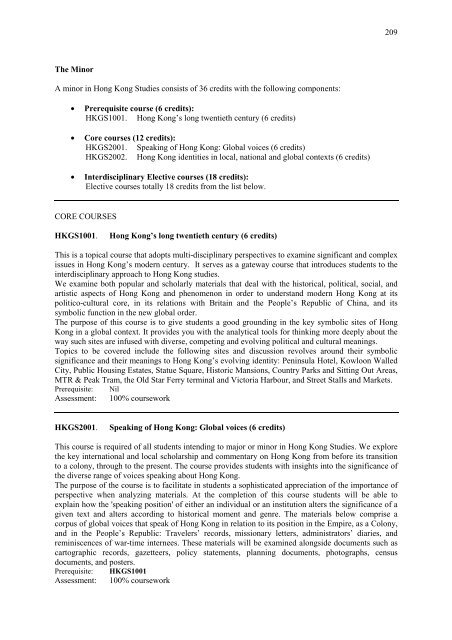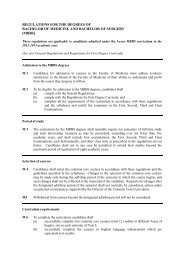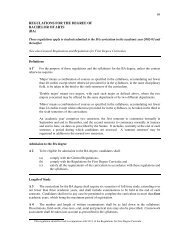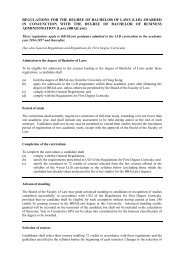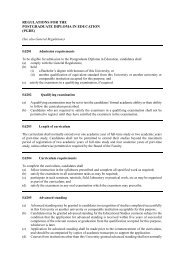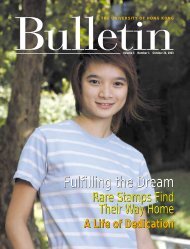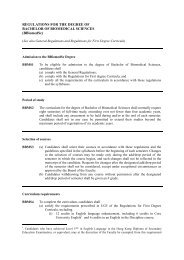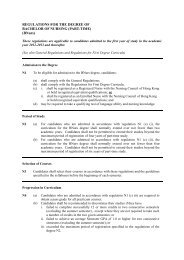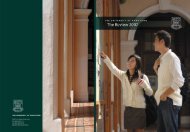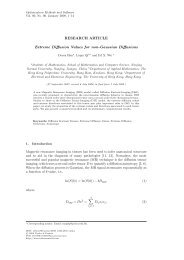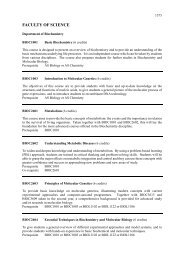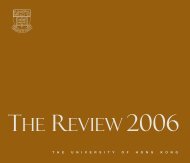(BA) (4-year-programme) - The University of Hong Kong
(BA) (4-year-programme) - The University of Hong Kong
(BA) (4-year-programme) - The University of Hong Kong
You also want an ePaper? Increase the reach of your titles
YUMPU automatically turns print PDFs into web optimized ePapers that Google loves.
209<strong>The</strong> MinorA minor in <strong>Hong</strong> <strong>Kong</strong> Studies consists <strong>of</strong> 36 credits with the following components:• Prerequisite course (6 credits):HKGS1001. <strong>Hong</strong> <strong>Kong</strong>’s long twentieth century (6 credits)• Core courses (12 credits):HKGS2001. Speaking <strong>of</strong> <strong>Hong</strong> <strong>Kong</strong>: Global voices (6 credits)HKGS2002. <strong>Hong</strong> <strong>Kong</strong> identities in local, national and global contexts (6 credits)• Interdisciplinary Elective courses (18 credits):Elective courses totally 18 credits from the list below.CORE COURSESHKGS1001.<strong>Hong</strong> <strong>Kong</strong>’s long twentieth century (6 credits)This is a topical course that adopts multi-disciplinary perspectives to examine significant and complexissues in <strong>Hong</strong> <strong>Kong</strong>’s modern century. It serves as a gateway course that introduces students to theinterdisciplinary approach to <strong>Hong</strong> <strong>Kong</strong> studies.We examine both popular and scholarly materials that deal with the historical, political, social, andartistic aspects <strong>of</strong> <strong>Hong</strong> <strong>Kong</strong> and phenomenon in order to understand modern <strong>Hong</strong> <strong>Kong</strong> at itspolitico-cultural core, in its relations with Britain and the People’s Republic <strong>of</strong> China, and itssymbolic function in the new global order.<strong>The</strong> purpose <strong>of</strong> this course is to give students a good grounding in the key symbolic sites <strong>of</strong> <strong>Hong</strong><strong>Kong</strong> in a global context. It provides you with the analytical tools for thinking more deeply about theway such sites are infused with diverse, competing and evolving political and cultural meanings.Topics to be covered include the following sites and discussion revolves around their symbolicsignificance and their meanings to <strong>Hong</strong> <strong>Kong</strong>’s evolving identity: Peninsula Hotel, Kowloon WalledCity, Public Housing Estates, Statue Square, Historic Mansions, Country Parks and Sitting Out Areas,MTR & Peak Tram, the Old Star Ferry terminal and Victoria Harbour, and Street Stalls and Markets.Prerequisite: NilAssessment: 100% courseworkHKGS2001.Speaking <strong>of</strong> <strong>Hong</strong> <strong>Kong</strong>: Global voices (6 credits)This course is required <strong>of</strong> all students intending to major or minor in <strong>Hong</strong> <strong>Kong</strong> Studies. We explorethe key international and local scholarship and commentary on <strong>Hong</strong> <strong>Kong</strong> from before its transitionto a colony, through to the present. <strong>The</strong> course provides students with insights into the significance <strong>of</strong>the diverse range <strong>of</strong> voices speaking about <strong>Hong</strong> <strong>Kong</strong>.<strong>The</strong> purpose <strong>of</strong> the course is to facilitate in students a sophisticated appreciation <strong>of</strong> the importance <strong>of</strong>perspective when analyzing materials. At the completion <strong>of</strong> this course students will be able toexplain how the 'speaking position' <strong>of</strong> either an individual or an institution alters the significance <strong>of</strong> agiven text and alters according to historical moment and genre. <strong>The</strong> materials below comprise acorpus <strong>of</strong> global voices that speak <strong>of</strong> <strong>Hong</strong> <strong>Kong</strong> in relation to its position in the Empire, as a Colony,and in the People’s Republic: Travelers’ records, missionary letters, administrators’ diaries, andreminiscences <strong>of</strong> war-time internees. <strong>The</strong>se materials will be examined alongside documents such ascartographic records, gazetteers, policy statements, planning documents, photographs, censusdocuments, and posters.Prerequisite: HKGS1001Assessment: 100% coursework


